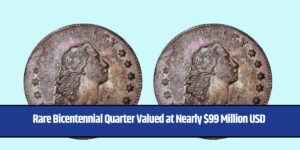Rare coins are more than just collectors’ items—they are tangible pieces of American history. From design quirks to fascinating backstories, these coins offer a glimpse into the early days of the United States and its evolving economy. Some of these coins have fetched millions at auction, captivating collectors and investors alike. Here’s a look at the 11 most expensive U.S. coins ever sold and the factors that make them so valuable.
The Crown Jewel: 1933 Saint-Gaudens Double Eagle
Topping the list is the legendary 1933 Saint-Gaudens Double Eagle, which sold for an astonishing $18.9 million in 2021. Originally minted as a $20 gold coin, its rarity stems from an abrupt historical shift. When the U.S. abandoned the gold standard, nearly all examples were melted down, leaving only a handful in existence. Its survival against the odds, combined with its beautiful design by Augustus Saint-Gaudens, solidified its place as the most valuable coin in history.
Early American Treasures
1794 Flowing Hair Silver Dollar
This $10 million coin holds a special place in numismatics as one of the first silver dollars ever minted in the U.S. Featuring Lady Liberty with flowing hair, it symbolizes the nation’s early aspirations of independence and unity.
1787 Brasher Doubloon
Selling for $9.36 million, the Brasher Doubloon is one of America’s earliest gold coins. Crafted by New York goldsmith Ephraim Brasher, this coin highlights the entrepreneurial spirit and craftsmanship of the post-Revolutionary War period.
Incredibly Rare Specimens
1822 Capped Bust Half Eagle
The 1822 Capped Bust Half Eagle fetched $8.4 million, thanks to its extreme rarity. Out of the three known examples, two are housed in the Smithsonian Institution, leaving just one privately owned coin. This exclusivity makes it one of the most coveted U.S. coins.
1804 Draped Bust Silver Dollar
Dubbed the “King of Coins,” the 1804 Draped Bust Silver Dollar achieved a price of $7.7 million. Surprisingly, these coins weren’t struck in 1804 but were minted decades later as part of diplomatic gift sets. This unusual backstory adds intrigue to their value.
Design Rarities and Errors
1861 Paquet Double Eagle
The 1861 Paquet Double Eagle, valued at $7.2 million, owes its worth to a design modification by Anthony Paquet. Only two examples exist, making this coin a prized piece for collectors who value unique variations.
1913 Liberty Head Nickel
With just five known specimens, the 1913 Liberty Head Nickel is among the rarest coins in U.S. history. One sold for $5.26 million, reflecting its legendary status and the intense demand among serious numismatists.
Early Experimental Pieces
1794 Silver Center Cent
The Silver Center Cent, auctioned for $2.6 million, represents innovation in early American coinage. Its distinctive design, which features a silver plug in the center of a copper coin, was an experiment to align its metal value with its face value.
1793 Chain Cent
As one of the first pennies ever produced, the 1793 Chain Cent brought in $2.35 million. Its design of interconnected chains symbolized the unity of the states, making it a meaningful artifact of the U.S. Mint’s earliest days.
Remarkable Mintage Stories
1804 Gold Eagle
Similar to its silver counterpart, the 1804 Gold Eagle was struck in the 1830s but dated 1804 for diplomatic purposes. It sold for $5.28 million, reflecting its scarcity and unique historical role.
1894-S Barber Dime
Rounding out the list is the 1894-S Barber Dime, which fetched $1.99 million. With only 24 originally minted and just nine known today, this dime’s rarity makes it one of the most valuable small coins in U.S. history.
What Drives Coin Value?
Several factors contribute to the staggering prices of these coins:
| Factor | Description |
|---|---|
| Historical Significance | Links to pivotal moments in U.S. history or early minting efforts add intrinsic value. |
| Rarity | Limited surviving examples make these coins highly desirable. |
| Condition | Coins in exceptional preservation command premium prices. |
| Story | Unique backstories or minting errors enhance their allure. |
| Collector Demand | Wealthy collectors and investors drive competitive bidding. |
The Market for Rare Coins
The record-breaking prices of these coins highlight the strength of the rare coin market. As more collectors enter the space, competition for these fixed-supply treasures intensifies, pushing prices higher. Beyond their monetary value, these coins serve as windows into America’s past, showcasing its craftsmanship, economic milestones, and cultural evolution.
For collectors, rare coins represent more than investment opportunities—they are pieces of history preserved in metal. While few can afford to own these legendary specimens, understanding their significance offers a deeper appreciation for numismatics. These coins prove that value lies not just in metal content or face value but in the stories and rarity that make them priceless artifacts.
Why is the 1933 Saint-Gaudens Double Eagle so valuable?
Its rarity and unique history, including its survival from being melted down, make it the most sought-after U.S. coin.
What factors determine the value of rare coins?
Key factors include rarity, condition, historical significance, and demand among collectors.
What is the oldest U.S. coin on this list?
The 1787 Brasher Doubloon is the oldest, crafted before the establishment of the U.S. Mint.
Are rare coins a good investment?
While they can offer significant returns, rare coins are also historical collectibles, making them a niche market.
How can I start collecting rare coins?
Begin by researching coin history, buying from reputable dealers, and focusing on affordable yet significant pieces.

















